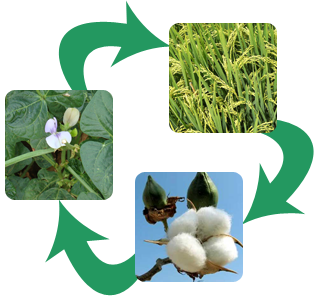Crop Rotation

- Non –leguminous crops should be followed by leguminous crops and vice-versa, eg. green gram – wheat / maize. If preceding crops are legume or non-legume grown as intercrops or mixed crops, the succeeding crop may be legume or non legume or both.
- Restorative crops should be followed by exhaustive or non-restorative crops.eg. seasame – cowpea / green gram / blackgram / groundnut.
- Leaf shedding crop should be followed by non-leaf shedding or less exhaustive crops.eg. pulses / cotton – wheat / rice.
- Green manuring crop should be followed by grain crops.eg. dhaincha - rice, green gram/ cowpea – wheat / maize.
- Highly fertilized crops should be followed by non-fertilised crop.eg. maize - black gram/gourds.
- Perennial or long duration crops should be followed by seasonal /restorative crops. eg. napier / sugarcane - groundnut /cowpea /green gram.
- Fodder crops should be followed by field or vegetable crops. eg. maize + cowpea-wheat/potato/cabbage/onion.
- Multicut crops should be succeeded by the seed crops. eg. green gram/maize.
- Ratoon crops should be followed by deep rooted restorative crops. eg. sugarcane/jowar-pigeonpea/Lucerne/cowpea.
- Fouling crops should be followed by cleaning crops.eg. jowar /maize potato/ groundnut.
- Cleaning crops should be followed by nursery crops. eg. potato/ colocasia/ turmeric / beet/ carrot-rice nursery/ onion nursery/ tobacco nursery/ vegetable nursery.
- Deep rooted crops should be succeeded by shallow rooted crops. eg. cotton/ castor/ pigeonpea – potato / lentil /green gram etc.
- Deep tillage crops should be followed by zero or minimal tillage crops. eg. potato / radish / sweet potato/sugarcane - black gram/green gram/green manuring crops.
- Dicot crops should be followed by monocot crops. eg, potato / mustard / groundnut / pulses – rice / wheat / sugarcane / jowar or dicot + Monocot crops should be followed by dicot + monocot or either dicot or monocot crops.
- Stiff stubble leaving crops should be followed by minimum intercultivation requiring crops. eg. sugarcane / sorghum/cotton /pigeonpea- fodder crops.
- The crops of wet (anaerobic) soil should be followed by the crops of dry (aerobic). eg. rice-Bengal gram/Lathyrus/pulses/oilseeds. The tendency to buildup difficult-to-control weeds becomes less in such rotation than in continuous wet land rice culture.
- The crops that are susceptible to soil-borne pests and pathogens should be followed by tolerant / break / trap crops. eg. sugarcane-marigold for pathogenic nematodes, tomato / brinjal / tobacco / potato-rice / pulses for Orobanche, jowar-castor for Striga and berseem-oats for Cuscuta.
- The crops with problematic weeds (weeds that are difficult to distinguish at any one stage of crop, may be seedling or seed stage) should be followed by cleaning crops / multicut crops / other dissimilar crops or varieties. eg. wheat-wet rice for Phalaris minor, berseem-potato / boro rice for Cichorium intybus, mustard early potato for Cleome viscose, rice-jute /sugarcane / vegetable/ maize + cowpea for Echinochloa crusgalli, jute- multicut fooder / vegetable or Corchorus acutangulus.
- Pasture crops should be followed by fodder or seed crop. eg. para grass – maize + cowpea / cowpea / rice bean / tetrakalai for seed.
- Silage / hay / cleaning crops should be followed by seed crops. eg. maize / groundnut - onion, cowpea / jowar for seed crops.
- Crops with the same symbiotic / associated microbes should be followed by common host crops, such as,
Rhizobium melilote - lucerna, sweet clover, fenugreek
R. trifolli - berseem, Persian clover
R. leguminosorum - peas, lentil, Lathyrus
R. phaseoli - beans, green gram, pillipesara, black gram
R. lupine - Lupines
R. japonicum - cowpea, pigeonpea, guar, sunhemp, Bengal gram, soybean, kudzu
- The rotational use of crop varieties, and cultural practices in addition to rotational cropping provides more and assured benefits than that of adopting only crops or land rotation.
|
|

